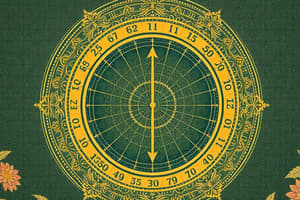Podcast
Questions and Answers
Which of the following is NOT a unit of length?
Which of the following is NOT a unit of length?
- mm
- km
- cm
- m² (correct)
Kilometre (km) is the most suitable unit for measuring the height of a building.
Kilometre (km) is the most suitable unit for measuring the height of a building.
False (B)
What is the name of the curved surface of liquid in a measuring cylinder?
What is the name of the curved surface of liquid in a measuring cylinder?
meniscus
0.35 kg is equal to ______ grams.
0.35 kg is equal to ______ grams.
Match the following instruments with their primary usage:
Match the following instruments with their primary usage:
Which instrument is used to measure temperature?
Which instrument is used to measure temperature?
A measuring cylinder is used to measure mass.
A measuring cylinder is used to measure mass.
What is the conversion of 1 kilogram to grams?
What is the conversion of 1 kilogram to grams?
The instrument used for measuring time is a ______.
The instrument used for measuring time is a ______.
Match the following quantities with their respective instruments:
Match the following quantities with their respective instruments:
What is the formula to calculate relative error?
What is the formula to calculate relative error?
Random error always shifts measurements in one direction only.
Random error always shifts measurements in one direction only.
How is random error estimated using the scale of a measuring apparatus?
How is random error estimated using the scale of a measuring apparatus?
The percentage error is calculated using the formula: (_____ / Measured value) × 100%.
The percentage error is calculated using the formula: (_____ / Measured value) × 100%.
Match the following terms with their definitions:
Match the following terms with their definitions:
What is the primary advantage of repeating an experiment?
What is the primary advantage of repeating an experiment?
Single measurements are always more accurate than averaged measurements.
Single measurements are always more accurate than averaged measurements.
How do you calculate the average value from multiple data points?
How do you calculate the average value from multiple data points?
To find the average value, you sum the data points and divide by the number of ______.
To find the average value, you sum the data points and divide by the number of ______.
Match the following trials with their respective data values:
Match the following trials with their respective data values:
What is the unit of measurement for temperature using a thermometer?
What is the unit of measurement for temperature using a thermometer?
An electronic balance is used to measure temperature.
An electronic balance is used to measure temperature.
What should you do when reading a measuring cylinder?
What should you do when reading a measuring cylinder?
The instrument used to measure time is called a ______.
The instrument used to measure time is called a ______.
Match each instrument with its corresponding measurement:
Match each instrument with its corresponding measurement:
Which of the following is the SI unit for mass?
Which of the following is the SI unit for mass?
The prefix 'milli' represents a factor of 100.
The prefix 'milli' represents a factor of 100.
What instrument is used to measure volume in millilitres?
What instrument is used to measure volume in millilitres?
The SI derived unit for energy is the _____ and its symbol is _____.
The SI derived unit for energy is the _____ and its symbol is _____.
Match the following base quantities with their respective SI base units:
Match the following base quantities with their respective SI base units:
What is the primary cause of systematic error?
What is the primary cause of systematic error?
Parallax error occurs when the scale is read from an angle that is not perpendicular to the measuring apparatus.
Parallax error occurs when the scale is read from an angle that is not perpendicular to the measuring apparatus.
What is zero error?
What is zero error?
If a ruler reads 6.5 cm instead of 6.0 cm when not in use, the zero error is _____ cm.
If a ruler reads 6.5 cm instead of 6.0 cm when not in use, the zero error is _____ cm.
Match the types of errors with their descriptions:
Match the types of errors with their descriptions:
What are the two fixed points used for marking a thermometer?
What are the two fixed points used for marking a thermometer?
Parallax error can be avoided by reading the ammeter from above the pointer.
Parallax error can be avoided by reading the ammeter from above the pointer.
What happens to the pointer's position on a thermometer when placed in a medium with a specific temperature?
What happens to the pointer's position on a thermometer when placed in a medium with a specific temperature?
The equation to find temperature is T = \frac{L_T}{L_{100}} \times ___
The equation to find temperature is T = \frac{L_T}{L_{100}} \times ___
Match the following components of the thermometer with their functions:
Match the following components of the thermometer with their functions:
At what temperature does the length of the thread equal 7.2 cm according to the example?
At what temperature does the length of the thread equal 7.2 cm according to the example?
How many equal intervals are there between the two fixed points on a thermometer?
How many equal intervals are there between the two fixed points on a thermometer?
The ammeter measures temperature.
The ammeter measures temperature.
Study Notes
International System of Units (SI)
- SI base units are the fundamental units of measurement for seven base quantities: length, mass, time, electric current, thermodynamic temperature, amount of substance, and luminous intensity.
- SI prefixes are used to denote multiples and submultiples of SI units.
- SI derived units are derived from the SI base units. They are used to measure quantities such as frequency, force, pressure, energy, power, electric charge, electric potential, electric resistance, and Celsius temperature.
Units and Conversions (Length)
- Millimetre (mm): Small units suitable for measuring small objects.
- Centimetre (cm): 1 cm = 10 mm. Commonly used for measuring everyday items.
- Metre (m): 1 m = 100 cm. Used for measuring larger distances.
- Kilometre (km): 1 km = 1000 m. Used for measuring long distances.
Units and Conversions (Volume)
- Millilitre (mL): Small units suitable for measuring liquid volume (1 mL = 1 cm³).
- Cubic centimetre (cm³): Also used for measuring liquid volume (1 cm³ = 1 mL).
- Litre (L): 1 L = 1000 mL. Used for measuring larger liquid volumes.
- Cubic metre (m³): 1 m³ = 1000 L. Used for measuring very large volumes.
Instruments for Measurement
- Length: Half-metre rule, metre rule, and measuring tape.
- Volume: Measuring cylinder.
- Mass: Electronic balance, spring balance, lever balance, triple beam balance, top pan balance, bathroom scale.
- Temperature: Thermometer (colored alcohol or mercury).
- Time: Stopwatch, watch, clock.
- Electric current: Ammeter.
Errors in Measurement
- Random error arises from the limitations of measuring instruments and/or the difficulty of precise measurements. It can be minimized by repeating measurements and calculating the average.
- Systematic error arises from faulty equipment or design flaws in the measurement process. It affects all measurements in the same direction, either always higher or always lower than the actual value.
- Parallax error occurs when the observer does not look at the measuring instrument perpendicular to the scale. It can be minimized by looking perpendicular to the scale.
- Zero error occurs when the measuring instrument does not read zero when it should. It can be corrected by adjusting the zero point.
Thermometer Marking
- Two fixed points, melting ice (0°C) and boiling water (100°C), are marked on the thermometer.
- The space between these points is divided into 100 equal intervals, each representing 1°C.
- The position of the liquid level in the thermometer indicates the temperature.
- Formula to calculate the temperature: T =
(L_T / L_100) * 100- Where:
- T = unknown temperature
- L_T = length of the thermometer's thread at the unknown temperature
- L_100 = length of the thermometer's thread at 100°C
- Where:
Finding the Average Value
- Repeating an experiment multiple times reduces the impact of random errors and provides a more accurate estimate of the true value.
- The average is calculated by summing the measurements and dividing by the number of measurements.
Accurate Readings
- Ruler: Read the scale vertically above the object being measured.
- Measuring Cylinder: Position your eyes at the level of the meniscus, the bottom of the curved liquid surface.
- Thermometer: Position your eyes at the level of the liquid inside the thermometer.
Studying That Suits You
Use AI to generate personalized quizzes and flashcards to suit your learning preferences.
Description
Test your knowledge on the International System of Units (SI), including base units, prefixes, and derived units. This quiz covers essential units of measurement such as length and volume, along with conversions between them. Perfect for students and professionals alike!



